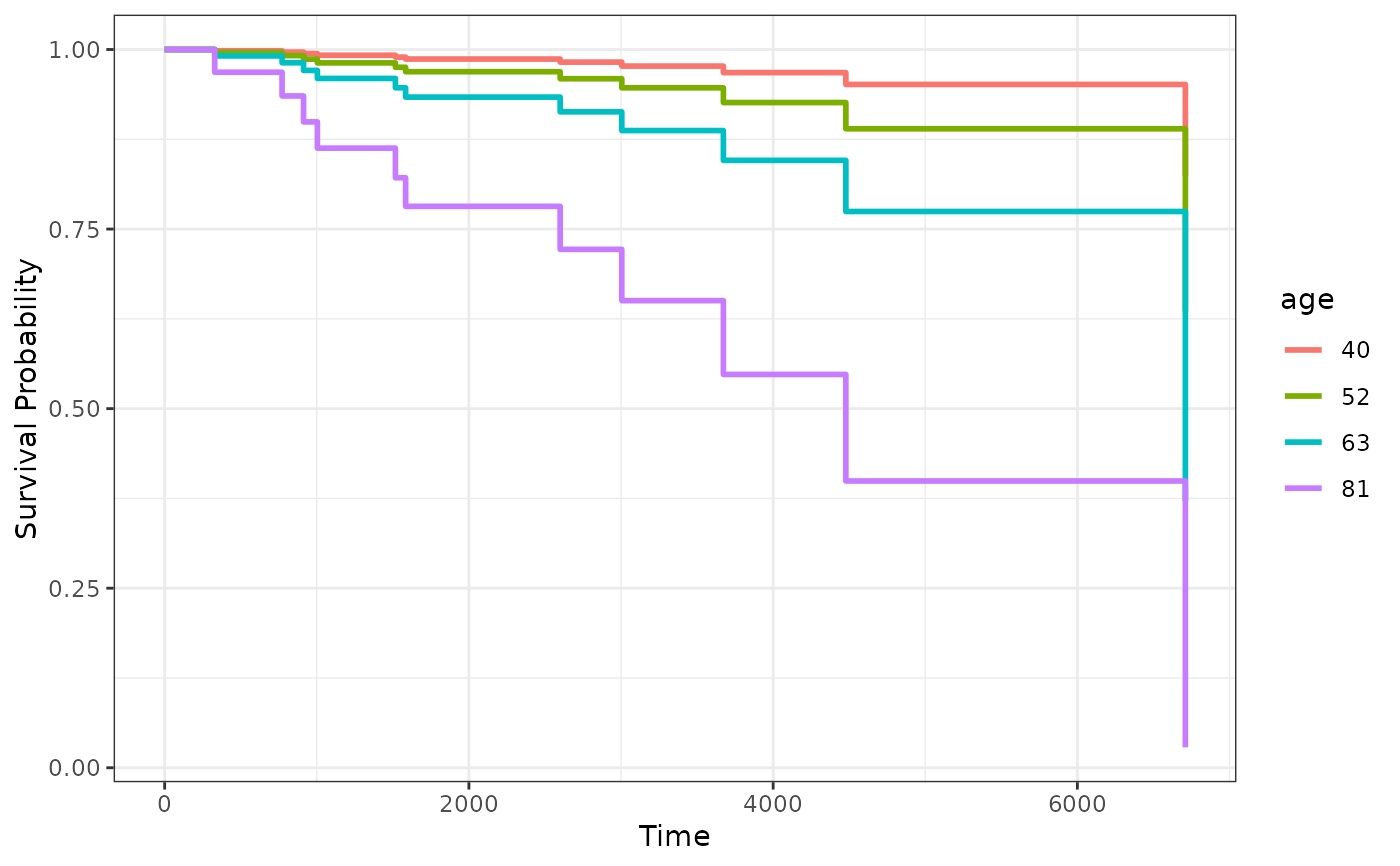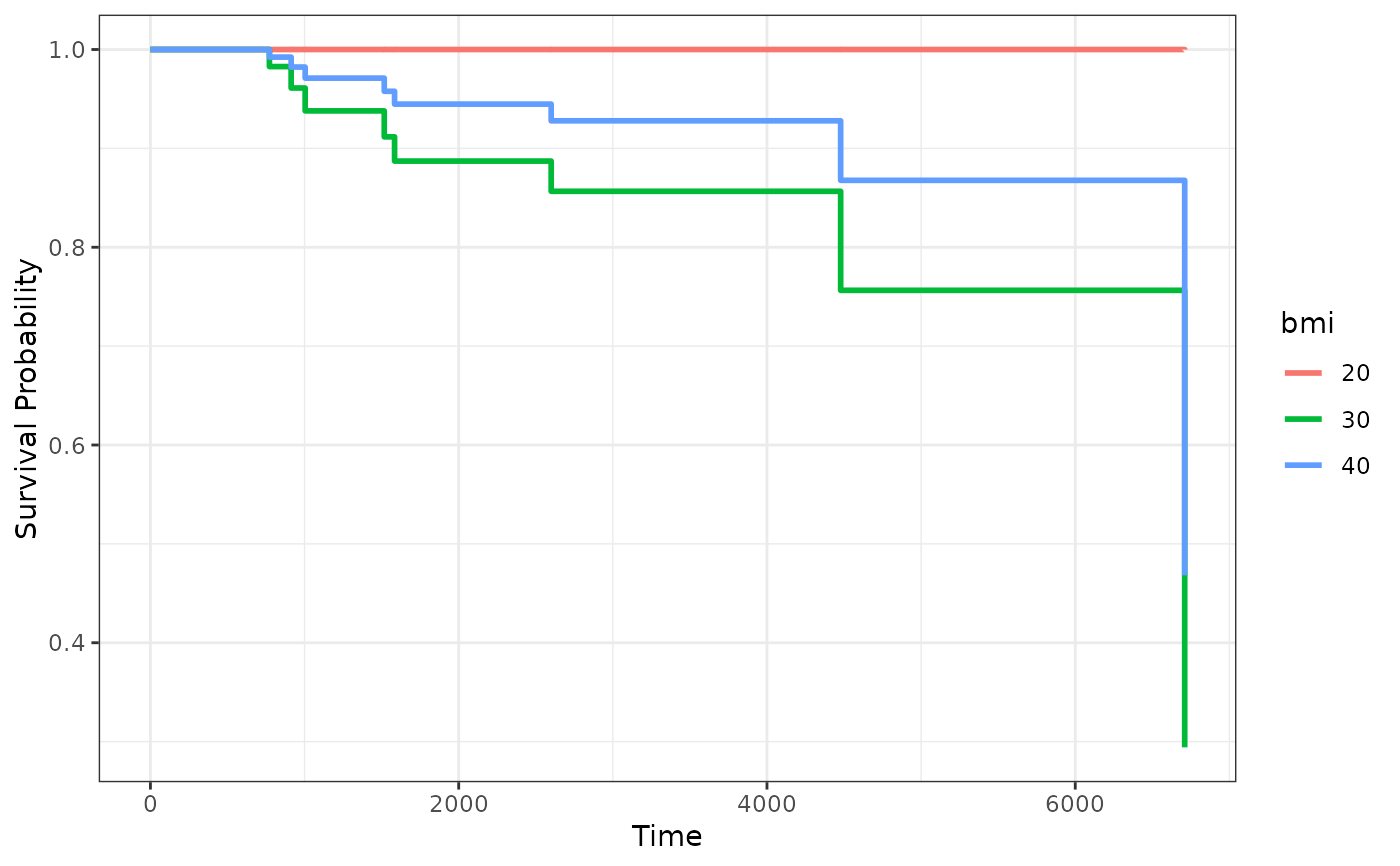
Plot Individual Survival Curves or CIFs for Specific Values of a Continuous Covariate
plot_surv_lines.RdUsing a previously fit time-to-event model, this function plots survival curves or CIFs that would have been observed if every individual in the dataset had been set to specific values of a continuous covariate.
Usage
plot_surv_lines(time, status, variable, group=NULL,
data, model, cif=FALSE, conf_int=FALSE,
conf_level=0.95, n_boot=300,
na.action=options()$na.action,
horizon=NULL, fixed_t=NULL, max_t=Inf,
discrete=TRUE, custom_colors=NULL,
start_color="blue", end_color="red",
size=1, linetype="solid", alpha=1,
xlab="Time", ylab="Survival Probability",
title=NULL, subtitle=NULL,
legend.title=variable, legend.position="right",
gg_theme=ggplot2::theme_bw(),
facet_args=list(), ci_alpha=0.4,
kaplan_meier=FALSE, km_size=0.5,
km_linetype="solid", km_alpha=1,
km_color="black", km_ci=FALSE,
km_ci_type="plain", km_ci_level=0.95,
km_ci_alpha=0.4, ...)Arguments
- time
A single character string specifying the time-to-event variable. Needs to be a valid column name of a numeric variable in
data.- status
A single character string specifying the status variable, indicating if a person has experienced an event or not. Needs to be a valid column name of a numeric or logical variable in
data.- variable
A single character string specifying the continuous variable of interest, for which the survival curves should be estimated. This variable has to be contained in the
data.framethat is supplied to thedataargument.- group
An optional single character string specifying a factor variable in
data. When used, the plot is created conditional on this factor variable, meaning that a facetted plot is produced with one facet for each level of the factor variable. Seecurve_contfor a detailed description of the estimation strategy. Set toNULL(default) to use no grouping variable.- data
A
data.framecontaining all required variables.- model
A model describing the time-to-event process (such as an
coxphmodel). Needs to includevariableas an independent variable. It also has to have an associatedpredictRiskmethod. See?predictRiskfor more details.- cif
Whether to plot the cumulative incidence (CIF) instead of the survival probability. If multiple failure types are present, the survival probability cannot be estimated in an unbiased way. This function will always return CIF estimates in that case.
- conf_int
Whether to plot point-wise bootstrap confidence intervals or not.
- conf_level
A number specifying the confidence level of the bootstrap confidence intervals. Ignored if
conf_int=FALSE.- n_boot
A single integer specifying how many bootstrap repetitions should be performed. Ignored if
conf_int=FALSE.- na.action
How missing values should be handled. Can be one of:
na.fail,na.omit,na.pass,na.excludeor a user-defined custom function. Also accepts strings of the function names. See?na.actionfor more details. By default it uses the na.action which is set in the global options by the respective user.- horizon
A numeric vector containing a range of values of
variablefor which the survival curves should be calculated orNULL(default). IfNULL, the horizon is constructed as a sequence from the lowest to the highest value observed invariablewith 12 equally spaced steps.- fixed_t
A numeric vector containing points in time at which the survival probabilities should be calculated or
NULL(default). IfNULL, the survival probability is estimated at every point in time at which an event occurred.- max_t
A number indicating the latest survival time which is to be plotted.
- discrete
Whether to use a continuous color scale or a discrete one (default). If
FALSE, the default ggplot2 colors are used.- custom_colors
An optional character vector of colors to use when
discrete=FALSE. Ignored ifdiscrete=TRUE, in which case the color gradient can be defined using thestart_colorandend_colorarguments.- start_color
The color used for the lowest value in
horizon. This and theend_colorargument can be used to specify custom continuous color scales used in the plot. For example, if a black and white plot is desired, the user can setstart_color="white"andend_color="black". See?scale_color_gradientfor more information.- end_color
The color used for the highest value in
horizon. See argumentstart_color.- size
A single number specifying the size of the drawn curves.
- linetype
A single character string specifying the linetype of the curves.
- alpha
The transparency level of the plot.
- xlab
A character string used as the x-axis label of the plot.
- ylab
A character string used as the y-axis label of the plot.
- title
A character string used as the title of the plot.
- subtitle
A character string used as the subtitle of the plot.
- legend.title
A character string used as the legend title of the plot.
- legend.position
Where to put the legend. See
?themefor more details.- gg_theme
A ggplot2 theme which is applied to the plot.
- facet_args
A named list of arguments that are passed to the
facet_wrapfunction call when creating a plot separated by groups. Ignored ifgroup=NULL. Any argument except thefacetsargument of thefacet_wrapfunction can be used. For example, if the user wants to allow free y-scales, this argument could be set tolist(scales="free_y").- ci_alpha
A single number defining the transparency level of the confidence interval bands.
- kaplan_meier
Whether to add a standard Kaplan-Meier estimator to the plot or not. If
groupis defined, the Kaplan-Meier estimator will be stratified by the grouping variable. Ifcif=TRUEwas used, the cumulative incidence will be displayed instead of the survival curve.- km_size
The size of the Kaplan-Meier line. Ignored if
kaplan_meier=FALSE.- km_linetype
The linetype of the Kaplan-Meier line. Ignored if
kaplan_meier=FALSE.- km_alpha
The transparency level of the Kaplan-Meier line. Ignored if
kaplan_meier=FALSE.- km_color
The color of the Kaplan-Meier line. Ignored if
kaplan_meier=FALSE.- km_ci
Whether to draw a confidence interval around the Kaplan-Meier estimates. Ignored if
kaplan_meier=FALSE.- km_ci_type
Which type of confidence interval to calculate for the Kaplan-Meier estimates. Corresponds to the
conf.typeargument in thesurvfitfunction. Ignored ifkaplan_meier=FALSEorkm_ci=FALSE.- km_ci_level
Which confidence level to use for the confidence interval of the Kaplan-Meier estimates. Ignored if
kaplan_meier=FALSEorkm_ci=FALSE.- km_ci_alpha
The transparency level of the confidence interval of the Kaplan-Meier estimates. Ignored if
kaplan_meier=FALSEorkm_ci=FALSE.- ...
Further arguments passed to
curve_cont.
Details
A simple plot of multiple covariate-specific survival curves. Internally, it uses the curve_cont function to calculate the survival curves.
Examples
library(contsurvplot)
library(riskRegression)
library(survival)
library(ggplot2)
library(splines)
# using data from the survival package
data(nafld, package="survival")
# take a random sample to keep example fast
set.seed(42)
nafld1 <- nafld1[sample(nrow(nafld1), 150), ]
# fit cox-model with age
model <- coxph(Surv(futime, status) ~ age, data=nafld1, x=TRUE)
# plot effect of age on survival using defaults
plot_surv_lines(time="futime",
status="status",
variable="age",
data=nafld1,
model=model)
#> Ignoring unknown labels:
#> • fill : "age"
 # plot it only for some specific user-defined values
plot_surv_lines(time="futime",
status="status",
variable="age",
data=nafld1,
model=model,
horizon=c(40, 52, 63, 81))
#> Ignoring unknown labels:
#> • fill : "age"
# plot it only for some specific user-defined values
plot_surv_lines(time="futime",
status="status",
variable="age",
data=nafld1,
model=model,
horizon=c(40, 52, 63, 81))
#> Ignoring unknown labels:
#> • fill : "age"
 ## showing non-linear effects
# fit cox-model with bmi modelled using B-Splines,
# adjusting for age and sex
model2 <- coxph(Surv(futime, status) ~ age + male + bs(bmi, df=3),
data=nafld1, x=TRUE)
# plot effect of bmi on survival
plot_surv_lines(time="futime",
status="status",
variable="bmi",
data=nafld1,
model=model2,
horizon=c(20, 30, 40))
#> Ignoring unknown labels:
#> • fill : "bmi"
## showing non-linear effects
# fit cox-model with bmi modelled using B-Splines,
# adjusting for age and sex
model2 <- coxph(Surv(futime, status) ~ age + male + bs(bmi, df=3),
data=nafld1, x=TRUE)
# plot effect of bmi on survival
plot_surv_lines(time="futime",
status="status",
variable="bmi",
data=nafld1,
model=model2,
horizon=c(20, 30, 40))
#> Ignoring unknown labels:
#> • fill : "bmi"
